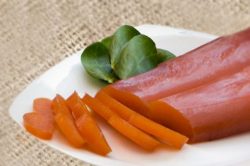Cosa vorresti visitare?
Cerca un luogo o qualcos'altro di tuo interesse in Sardegna...
Cerca un luogo o qualcos'altro di tuo interesse in Sardegna...
The rural group of Cabras dates back to the end of the 11th century under the name of “Masone de Capras”. On the banks of its pond, the Arborea courts possessed a fortress residence, the “Villa de Capras”, of which today very few ruins remain. Concluded in 1410 the experience of the Judge Arborea, with the establishment of the Marquisate of Oristano, (fief of the family Cubello) Cabras became part of the vast territories ex-judicial from it incorporated. The Arborea were defeated in 1478 at the hands of the Catalan-Aragonese who thus assumed the territories of the former marquisate of Oristano finally ceded to Spain. In 1479, Oristano became City director and the three Campidani, of which Cabras was part, were placed under his jurisdiction.
In the last weeks of August, Cabras and the village of San Salvatore are enlivened for the performance of an event known as the “Corsican of Scalzi”. [Huge_it_slider id = “3”] The event begins in the last weeks of August, when the women of Cabras, Discalced and dressed in the typical costume of the country, carry in procession the image of the saint from the church Santa Maria to the sanctuary of San Salvatore. In the village religious rites are held for nine days. The actual race begins after the first mass of the first Saturday in September. The men of the country wearing “s ‘ Abidu” (Gown of Brotherhood) meet in the churchyard of the major church of Cabras and from there the image is carried in procession to the periphery of the country. “Is Curridoris” (pronounced “curridorisi” in Italian “runners”) run to the village of San Salvatore di Sinis shouting “Viva Santu Srabadoi”. Two runners carry the sedan with the image that is never exceeded. Every hundred meters the change is made. The same ritual takes place in the opposite direction the next day. Upon arrival, the procession will end in front of the churchyard of the Church of Santa Maria Assunta. The following Monday the women in procession carry the image in the Church of the greater. The rite is propitiatory of a good harvest, fertility of the flocks and abundant peach.
 The ROE is a food made of Roe of Mullet worked in order to become a real “caviar”. It is often used grated or flakes in multiple courses of appetizers, first and second but lately it is also produced as Cream spreadable in bread. The festival held in August in the country is dedicated to this food, during which it is possible to taste excellent dishes served in various stands in the streets of the center and the Square pond that for the event offers a suggestive atmosphere and good music, in fact every year different Artists perform on the stage set up for the occasion.
The ROE is a food made of Roe of Mullet worked in order to become a real “caviar”. It is often used grated or flakes in multiple courses of appetizers, first and second but lately it is also produced as Cream spreadable in bread. The festival held in August in the country is dedicated to this food, during which it is possible to taste excellent dishes served in various stands in the streets of the center and the Square pond that for the event offers a suggestive atmosphere and good music, in fact every year different Artists perform on the stage set up for the occasion.